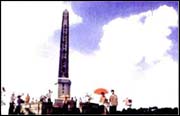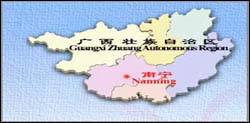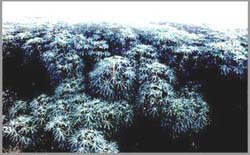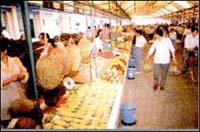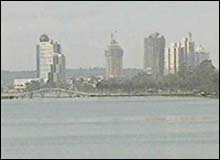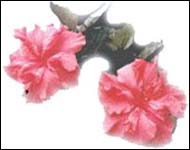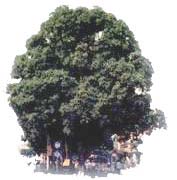History Nanning
Nanning, with a glorious tradition, is remembered as a heroic city in the minds of Chinese people. For thousands of years, the city has undergone countless tests in battle. In the old days, Su Jian, head officer of this region in song Dynasty, once led the army and people throughout Yongzhou City to resist the Vietnamese aggressors, who were waging war against China. |
|
In modern times, the famous generals Liu Yongfu and Feng Zicai bravely safeguarded the region against French aggressors in a bid to defend their homeland. Moreover, the city has also witnessed glorious deeds by locals as following: the 1911 Revolution, the May 4th Movement in 1919, dispatching troops to aid the Northern Expeditionary Armies, the founding of the Seventh and Eighth Armies of the Chinese Workers' and Peasants' Red Army, the Baise Uprising paving the way for establishing the Zuojiang and Youjiang revolutionary bases, the Longzhou Uprising and the bloody Kunlunguan Campaign which gave a heavy blow to the Japanese aggressors. The local people have added an illustrious chapter to the history of defending the homeland and pursuing social progress by safeguarding the South Gate of the motherland and participating in the socialist construction of New China.
In 1958, Nanning became the capital of Guangxi Chuang Nationality Municipality.
Geography Nanning
|
Nanning City is located between 107o45'-108o51'eastern longitude and 22o12'-23o32'northern latitude. The downtown area lies in the Nanning Basin, one of the four largest in Guangxi Zhuang Autonomous region, with an average elevation of 80 to 100 meters. The highest point is 496 meters above sea level. The major river within Nanning is the Yujiang River, |
the largest tributary of the Xijiang River, and the section of it running through the city is known as the Yongjiang River and joins the Pearl River System.
Climate Nanning
Located to the south of the tropic of cancer, Nanning has a monsoon climate characteristic of the subtropical zone and is influenced by the regulation of a maritime climate. The city is full of sunshine with abundant rainfall, but with little frost and no snowfall. The annual average temperature is 21.7 degrees centigrade, with the annual average precipitation of 1300 mm. |
|
The frost-free period is between 345 and 360 days. There is an old saying that "grass never withers, even in winter; flowers always bloom, even not in spring."
Economy Nanning
|
Nanning is a booming city facing Southeast Asia and backing Southwest China. It adjoins Guangdong Province, Hong Kong and Macao in the east. It is an important hub city available to Southwest China as they open to international economies, as well as an exchange center for economic circles in southern, southwestern and southeastern China. |
As one of the hotspots of China's economic development, Nanning has witnessed earth-shaking changes in this regard through five decades of economic construction.
Since the reform policies were introduced, directed by the development strategy of "Using science and education to vitalize the city, agriculture to stabilize the city, industry as the base of the city, the third industry to make the city rich, and to govern the city according to laws", Nanning has gradually adjusted its structure of industry and formed the rising industry group with focus on biology and pharmacy, electronic information, new material and electro mechanics.
The agriculture is developing in the direction of high yield, high quality and effectiveness. In 1997, the increase of the third industry in Nanning equals 49.66 percent of GDP in Nanning. The scope of economic development has expanded rapidly, bringing a new look to the city as it changes with each passing day. Also, various undertakings in the fields of science, education, culture and sports have been vigorously developed.
Culture Nanning
Nanning is the center of science and technology, education, culture and sanitation Guangxi Province. There are altogether 54 scientific research institutes subordinate to districts. 10 colleges and 50 trade schools are training specialty personnel of all kinds for society. Now there are 62 mass cultural organizations, 13 performing groups, 8 cinemas, 285 projecting units,over 70 karaoke halls and over 1000 newsstands. The bookshops and cultural markets, which can be found every where and the broadcast and TV not only infinitely enrich Nanning citizens' culture life in spare time,
|
|
but also help to improve their quality and the civilization degree of the city.
A Survey of Tourist Industry Nanning
|
Nanning, the capital of Guangxi Zhuang Autonomous Region, is the political, economic and cultural center of the region, and a modern and booming city full of vitality with rapid economic development achievements. It covers a total area of 10,029 square kilometers and has a population of more than 2.8 million.
As one of the country's top 50 cities in terms of comprehensive economic strength, Nanning has been giver the title of "Sanitary City throughout China", |
"Advanced City with achievements in the comprehensive treatment regarding the city's environment", "Model City with outstanding deeds in "double supports" (namely, supporting the government and cherishing the people as well as supporting the army and giving preferential treatment to families of soldiers and martyrs), "Garden City of China", one of the "Top Tourist Cities of China" and "Advanced City in Building Spiritual Civilization", which demonstrates a new look of the city based on the beautiful environment and civilization in the days of opening to the world.
Nanning, with obvious geographic superiority, faces Southeast Asia, backs the southwest of China, adjoins Guangdong, Hong Kong and Macao in the east, and borders on Laos, Viet Nam and Cambodia in the west. It is a center for exchange between the three economic circles of South and Southwest China and Southeast Asia, playing and important role in the fields of exchange and cooperation in these areas.
In 1992, the central government introduced the strategy of giving reins to Guangxi's geographical position as a channel to the southwest and a window to the outside world. Nanning, as a centerpiece among Guangxi's coastal cities, has gradually become a thoroughfare of transit for areas in Southwest China seeking to gain access to the outside world and as an important gateway for importing commodities for Southwest China.
Nanning is blessed with sound natural conditions. Nanning is located in a monsoon region in the south of a subtropical zone, with an annual average temperature of 21.7 centigrade degrees. Winter normally doesn't touch the area, with migratory birds spending the entire year. The city is surrounded by clear rivers and green mountains, with fields of fragrant fruits.
With vegetation cover rate of nearly 40 percent, the city has earned the reputation of China's "Greening Capital" and has given visitors the impression that Nanning is blanketed by foliage and have made the green environment a symbol of Nanning. Nanning borders on Guilin in the north, which is famed for its incredible scenery. To its south is the beautiful seashore of Beihai, which is one of the three top tourist attractions in Guangxi. The area attracts numerous travelers each year eager to see the unique landscape, to witness the lives and customs of the local ethnic minorities, and to enjoy the tropical coastline and explore the rainforest-covered mountains. Topical tours give visitors a chance to appreciate the pastoral landscape of southern China, the charm of frontier rivers and mountains, the lifestyle of the Yao ethnic minority in Guangxi Zhuang Autonomou Region, and the unique features of different counties and cities. Among the special tours are the "Tour to Appreciate the Beauty of the Green Capital", "Tour to the Dreamlike World of Trans-national Landscape". The local authorities are doing their best to attract tourists from all corners of the world by relying on the area's unique tourism resources. It has become an important gateway for travel along the Sino-Vietnamese border and into Southeast Asia.
Nanning boasts convenient transportation network radiating in all directions and combining waterways, highways, railways and air travel. More than 30 passenger trains arrive each day from major cities throughout the country as well as international trains from Hanoi, the capital of Vietnam. The newly expanded Nanning International Airport has opened to more than 30 domestic and international airlines linking Nanning with the country's major cities and Hong Kong, Hanoi and Bangkok, with some 200 scheduled flights each week. The modern terminal, with an area of nearly 30,000 square meters, has enhanced the handling capacity of Nanning Airport to a great extent. Expressways and other trunk roads radiate to all corners of the city, and a highway network centered on Nanning extends in all directions. Moreover, the city has convenient and quick waterway access along the Xijiang River to Guangdong, Hong Kong and Macao. The transportation inside the city is also convenient and fast, for there are altogether over 2,000 tour-buses, medium-buses and other vehicles, and cars available.
Nanning has witnessed the improvement of tourism facilities with each passing day. It has 21 foreign-related hotels ranging from one-star to five-star, with a total of 10,000 beds. Among these, the four-star Yongjiang Hotel was rated as one of the Top 50 Tourist Hotels with economic potential throughout the country. In addition, the city has 51 travel agencies, which include 16 international travel agencies and 35 domestic agencies.
Nanning has witnessed increasing growth in the number of visitors and income earned from tourism year by year. In 1998 alone, the city received 26,260 overseas tourists, earning foreign exchange totaling US$7.0663 million, some 5.01 percent of the city's total income. An addition of 6.89 million domestic visitors brought CNY 3.23 billion yuan into the city, some 19.95 percent of the total. Such achievements made Nanning the second place in the whole region in that year.
The Major tourist attractions in Nanning are as following:
*Qingxiu Mountain Landscape (a park at provincial level);
*Guangxi Museum;
*Guangxi Medicinal Botanical Garden;
*Liangfengjiang River Scenic Spot (a state forest reserve);
*Phoenix Lake Holiday Site
*Minorities Cultural Relics Center
*Western Suburbs Zoo (including the country's largest Crocodile Enclosure, Elephant Enclosure and Hippopotamus Enclosure);
*Golden Scented-Tea Park (the country's largest base for golden scented tea seeds);
*The Ruins of the Battlefield of Kunlunguan (the Memorial hall for martyrs of the anti-Japanese war);
*Yangmei Ancient Town;
*Lingshui Hot Spring (a large constant hot spring);
*Mingxiu Park;
*Daming Muntain (as beautiful as Lushan);
*The Beiqiu ruins of Dingshishan Mountain (one of the 1997's 10 Greatest Archaeological Discoveries in China.)
City Flower Nanning
The jaba is an evergreen shrub that is found in several varieties. The bright color of its blossoms and the long period of bloom have earned it the place as the official city flower.
City Tree Nanning
|
|
|
The official city tree of Nanning is the almond tree, with its straight trunk, clean-cut crown and tasty fruit. It is regarded as the backbone tree used for greening and landscaping throughout the city.
Geographic Advantages Nanning
1. An open city along China' s coastline
Nanning borders on Beibu Bay in the south, only 204 kilometers from Beihai, 173 kilometers from Fangcheng Port, and 104 kilometers from Qinzhou City, which are the three biggest harborin Guangxi. The distance from Guangxi seaports to Southeast Asia and Africa is the nearest in China.
|
The numerous natural harbors along the coastline of Guangxi have given rise to 21 harbors of various sizes with a combined potential handling capacitv of over 100 million tons. Current plans call for the number of births to reach 18 at different levels ranging from 10,000 to 100,000 tons. The city government has worked out a development strategy for the coastal areas centered on Nanning, Beihai, Qinzhou and Fangcheng Harbor, giving full play to the role of the big cities along the Guangxi coast and radiating to other areas. Undoubtedly, this area will become the most active region in terms of economic development in Guangxi and southeastern China, as well as a new hot spot for economic take-off along the coast.
2. A capital city along the border ling
Guangxi has eight counties, which borders on Vietnam and 11 border ports within the area. Nanning is only 230 kilometers from Pingxiang Port and only 204 kilometers from Dongxing Port along the Sino-Vietnamese border. There are seven counties and cities around Nanning, which are on the borderline with Vietnam. The total length of the overland borderline is 1,020 kilometers. Therefore, it offers favorable conditions for developing the border trade.
3. A harbor city along the inland river
Nanning is one of the four inland-river harbors along the Xijiang River system within Guangxi. The Xijiang River, coming down from the Yunnan Guizhou Plateau, runs through Guangxi, via Guangdong to the South China Sea. It is a golden waterway linking Hong Kong and Macao with Southwest China. There are eight shipping routes available along the inland river, which connect Nanning with Guangzhou, Hong Kong, Shenzhen and Wuzhou, as well as other cities. The second phase of improvements along the Xijiang River waterway iexpected to be completed soon.
|
